- News
- Reviews
- Bikes
- Components
- Bar tape & grips
- Bottom brackets
- Brake & gear cables
- Brake & STI levers
- Brake pads & spares
- Brakes
- Cassettes & freewheels
- Chains
- Chainsets & chainrings
- Derailleurs - front
- Derailleurs - rear
- Forks
- Gear levers & shifters
- Groupsets
- Handlebars & extensions
- Headsets
- Hubs
- Inner tubes
- Pedals
- Quick releases & skewers
- Saddles
- Seatposts
- Stems
- Wheels
- Tyres
- Tubeless valves
- Accessories
- Accessories - misc
- Computer mounts
- Bags
- Bar ends
- Bike bags & cases
- Bottle cages
- Bottles
- Cameras
- Car racks
- Child seats
- Computers
- Glasses
- GPS units
- Helmets
- Lights - front
- Lights - rear
- Lights - sets
- Locks
- Mirrors
- Mudguards
- Racks
- Pumps & CO2 inflators
- Puncture kits
- Reflectives
- Smart watches
- Stands and racks
- Trailers
- Clothing
- Health, fitness and nutrition
- Tools and workshop
- Miscellaneous
- Buyers Guides
- Features
- Forum
- Recommends
- Podcast
TECH NEWS
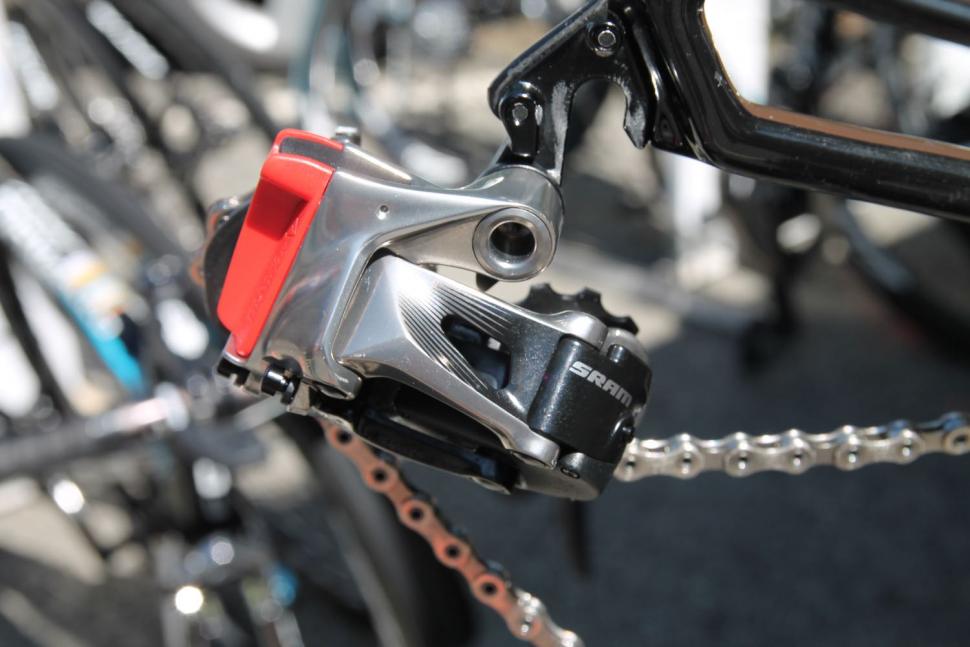 SRAM Wireless - 11 (1)
SRAM Wireless - 11 (1)SRAM’s wireless groupset spotted - massive photo gallery
It’s no secret that SRAM has been working on a wireless electronic groupset. We first saw it on bikes at the Tour of California last year, and it’s been spotted on numerous occasions since.
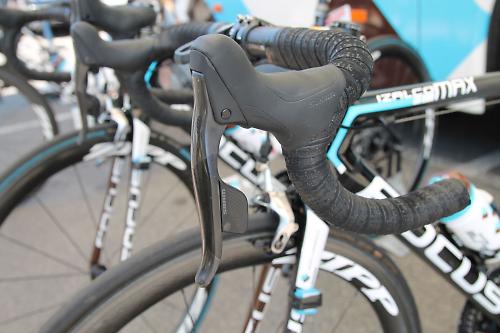
I was at the start and finish of the final stage of the Route du Sud today in the beautiful south of France (and the weather is lovely by the way) and several of the AG2R Focus team bikes were equipped with the new wireless groupset.
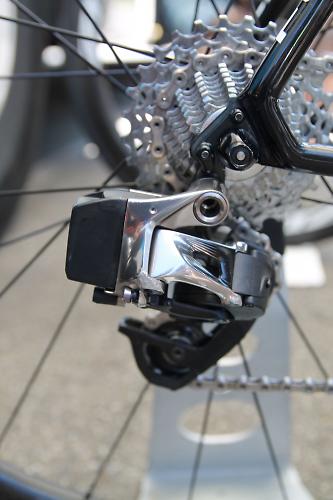
This is the first time I’ve seen the new groupset in the flesh. Looking at it this closely, one thing is very much clear: it looks ready for production. From the graphics on the rear mech, embossed SRAM logos and the ‘Red’ logo on the carbon fibre brake levers obscured only by a strip of black electrical tape, it’s clear the parts aren't at the prototype stage and are being properly manufactured.

Few details have emerged about the new groupset. SRAM is remaining tight-lipped until it decides to officially unveil it, most likely at the Tour de France. One aspect of its functionality was revealed while I watched the mechanics wash and clean the bikes after the stage.
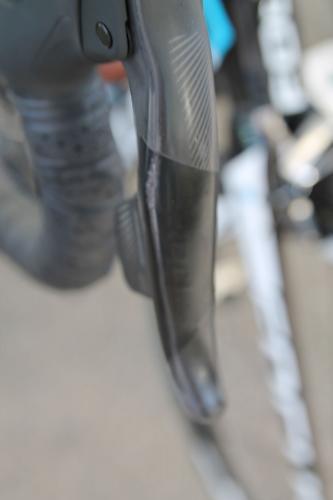
The batteries, the large black plastic units hanging off the back of each mech, are removable. That much was easy to deduce from early photos, but I actually watched a mechanic remove the batteries. And it’s very simple. A clip on the top flips up, the battery pops off, and a red plastic blanking plate is installed to protect the metal contacts while the bike is washed.
.jpg)
The red plastic cover protects the contacts when the battery is removed for charging
One obvious advantage of the removable batteries is that you don’t have to store your bicycle near a mains power supply, as you do with Di2. I would imagine SRAM has developed its own dock to charge the batteries. It’s not clear how long the batteries last, but combined the two batteries appear the about the same size as a Shimano battery.
.jpg)
With the battery removed, exposing the metal contacts
Despite the clear readiness of these components, SRAM seems to be keen to get as many race miles as possible logged on the groupset, which is why it’s been spotted at so many races in the last year. SRAM clearly doesn’t want a repeat of the hydraulic disc brake recall. There aren't as many teams using SRAM as a few years ago, but there’s an increasing number of AG2R racers on the new groupset, so it’s slowly being rolled out. We’d expect to see the entire team on the wireless groupset at the Tour de France.
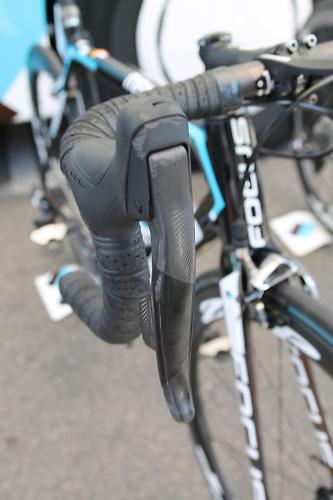
The components in AG2R's bikes have clearly been getting plenty of use; just look at all the scrapes and scratches. That suggests the groupset can handle the odd knock and crash, which bodes well for its launch. Parts used by the pros need to be reliable and tough.
.jpg)
SRAM's wireless group doesn't appear to have a similar central control module. That's different from Shimano’s Di2 which uses a control module, commonly mounted under the stem, which is used to charge the battery and also to set up the indexing and to make indexing changes during riding. It’s not clear how SRAM's transmission is first set up when installed on a bike, or how changes are made if the indexing gets knocked out of alignment, say following a crash.
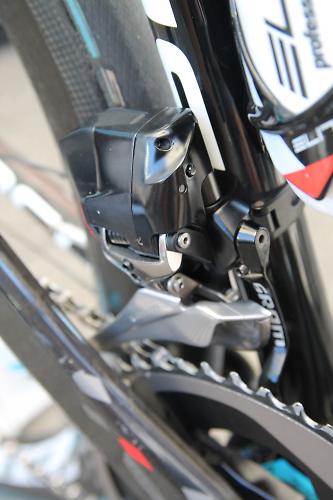
Related story: SRAM's wireless shifting—a saboteur's dream?
The shape of lever hoods don’t appear dramatically different to regular RED mechanical shifters, but the pointy bit is a bit more, well, pointy, suggesting SRAM has managed to package the electronic gubbins more compactly than its hydraulic brake levers.
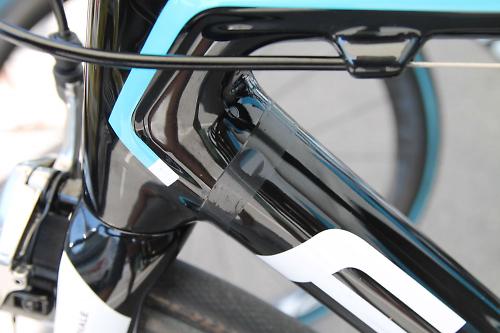
This frame has the Di2 ports taped over because, with no wires, they’re redundant.
David worked on the road.cc tech team from 2012-2020. Previously he was editor of Bikemagic.com and before that staff writer at RCUK. He's a seasoned cyclist of all disciplines, from road to mountain biking, touring to cyclo-cross, he only wishes he had time to ride them all. He's mildly competitive, though he'll never admit it, and is a frequent road racer but is too lazy to do really well. He currently resides in the Cotswolds, and you can now find him over on his own YouTube channel David Arthur - Just Ride Bikes.
Latest Comments
- PRSboy 2 sec ago
Another thing ruined by the Americans
- Miller 1 hour 19 min ago
Nice to see WvA featuring in the finale.
- Miller 1 hour 21 min ago
I have known more than one elder statesman of the club die of a heart failure while out on a ride. Sometimes I feel that's about to happen to me,...
- Pub bike 1 hour 39 min ago
Via the "wireless active steering system".
- AidanR 1 hour 47 min ago
It does say "so-called reciprocol" to be fair. But I agree, Trump calling the tariffs reciprocol is disingenuous at best, given that they are based...
- Hirsute 2 hours 2 min ago
137m is the farthest I have observed when quickly looking at the Garmin unit....
- pockstone 2 hours 20 min ago
Yours worked wonders, but if you insist, I'll hop to it...why the need for extra police? Did the fire brigade bottle it?
- Jamminatrix 2 hours 34 min ago
As if Tadej Pogacar's slavery-supporting jersey is any different...
- BikingBud 6 hours 4 min ago
Do you mean this woman, who got out to marshall the truck through and is now walking back to said Wankpanzer which is blocking the road again as it...
- Pub bike 2 hours 8 min ago
He is up against the global trading system, which has obviously been in the news a lot lately. Framebuilders in other countries can undercut him,...
Add new comment
50 comments
CR-2032 battery operated devices are a pretty well understood thing - it's not impossible they'll fuck it up but when was the last time anyone really worried about coin battery interfaces to sensor / devices on bikes ? (or anywhere really)
To be fair to them, they do seem to be giving it a good going over before release although you're right of course - Conan the Amateur Mechanic will give it some abuse professionals could only dream of..
After the hydraulic rim brakes recall they would never to risk another one.
Garmin. A well trodden path of CR-2032 issues on Cadence sensors and HRMs.
Blimey - I stand corrected, that's an eye-opener (especially the 'overload' issue), thank you. It really, really isn't difficult to do right... idiots.
The HRM is the worst, you have to short it with tin foil or a paper clip or turn the battery over practically once a month and I've had three, all exactly the same. I don't fancy having to do that mid-ride to get my gears to work. I've now got a Polar HRM and it hasn't done it..... Yet.
If I'm honest, four batteries worries me, especially the two CR-2032. I'll wait to see how the early adopters get on before deciding if this is, indeed for me.
I've had a Garmin non-premium HRM for well over two years now - replaced the battery once with no issue, no faffing around. Works a blinder, never let me down and not heard much bad said against them specifically (apart from "it's not comfortable" which I find a little odd). Is it an issue with the premium one ? (of which has had more than it's share, not battery related).
All mine were the premium so possibly.
I have the same issue with two different GSC 10 Cadence sensors that I run too. As these and the HRMs are the only CR-2032 items I own, it's why I'm in full strokey chin mode.
Indeed, I can see your point, as I said - an eye-opener. What's galling is that there are legions of coin battery operated devices around, even some cheap crap from the Far East, that manage to do this correctly - and Garmin seem to have really dropped the ball with it, at least with some of their stuff. The premium HRM was already renowned for contact issues and general flakiness, i'll add this to the list.
I assume the shifters need batteries too, but they'll need charging less often?
Yes, CR-2032 type, non-chargeable last I heard.
This has GOT to be the future of electric gearing, why would anyone want the hassle of routing wires through a frame when you can bypass the whole process. How could anyone not want this innovation.
Doubtless in a couple of years we'll see claims from frame manufacturer marketing teams such as '20% increased stiffness due to not needing to drill holes in frames'... and... 'due to reduced manufacturing processes riding this bike will make fairy dust come out of your bottom when decending'.
If the battery is removed for washing, how will the system cope in a heavy downpour?
There's a huge difference between a downpour, where a lot of water flows under low pressure, and pressure washing. Consdering how much time SRAM spend on polishing and testing the design, I remain optimistic.
kwi - you've heard what I've heard.
I did ask them a few details but understandably, neither the team or Lisa would give me any detail about it.
The 'both paddle's together' front shift does sound a bit odd - and a bit imprecise for a racing situation. I have long suspected that this a a smokescreen, and really SRAM will have intelligent sequential shifting.
We will see soon....
My money is on Shimano 'fighting back' by rolling out its electronic shifting to the 105 level...
Also waiting for 105 level, not Di2, but the hydro one for commuter bike.
BTW, even 105 Di2 is out, the battery and wire thing is still a problem...
For my TCR frame, the rear derailleur cable needs extra zip ties as the hole is a little far for Di2...
Also I'm also worried about the internal battery, as the seatpost is in water drop shape...
Still waiting to hear how the shifting will work, have heard left paddle down/right paddle up/both for F.mech. The last bit doesn't feel right and I hope some form of synchro shift is employed.
The Canyon product man, who has ridden the new groupset, pretty much confirmed to me today that that is how the new groupset will operate. As with any new shifting setup, such as when SRAM first introduced DoubleTap, it'll take a bit of getting used to, but I'm sure it won't take that long to adapt
Lisa Brennauer won the Aviva Women's Tour this week - she rides from Velocio SRAM so they look to be another of their test teams. Loren Rowney her team-mate was also running it.
Looking around the pits they appeared to be the only team completely running SRAM (a few odd riders in the national teams had it). Wiggle and Ale Cippolini run Campy and the rest were running Shimano.
SRAM is ahead of another big S now...
The integrated battery on deraulleur is much better than the wired-to-battery design from Shimano.
No ugly external battery or wired batter cable routing now.
Eager to see what Shimano will bring to strike back.
Pages